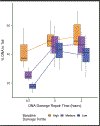Frailty, sex, and poverty are associated with DNA damage and repair in frail, middle-aged urban adults
- PMID: 37437502
- PMCID: PMC10807508
- DOI: 10.1016/j.dnarep.2023.103530
Frailty, sex, and poverty are associated with DNA damage and repair in frail, middle-aged urban adults
Abstract
Frailty is an age-related syndrome characterized by reduced recovery from stressors and increased risks of morbidity and mortality. Although frailty is usually studied in those over 65 years, our previous work showed that frailty is both present and a risk factor for premature mortality in midlife. We identified altered gene expression patterns and biological pathways associated with inflammation in frailty. Evidence suggests DNA oxidation damage related to inflammation accumulates with age, and that DNA repair capacity (DRC) declines with age and age-related conditions. We hypothesized that inter-individual differences in DNA oxidation damage and DRC are associated with frailty status and poverty level. Using the CometChip assay, we assessed baseline single-strand breaks and hydrogen peroxide (H2O2)-induced DNA oxidation damage and DRC in non-frail and frail middle-aged African American and White individuals with household incomes above and below poverty. Analysis of baseline single-strand breaks showed no associations with frailty, poverty, race, or sex. However, we identified an interaction between frailty and poverty in H2O2-induced DNA oxidation damage. We also identified interactions between sex and frailty as well as sex and poverty status with DRC. The social determinant of health, poverty, associates with DRC in men. Baseline DNA damage, H2O2-induced DNA damage as well as DRC were associated with serum cytokine levels. IL-10 levels were inversely associated with baseline DNA damage as well as H2O2-induced DNA damage, DRC was altered by IL-4 levels and sex, and by TNF-α levels in the context of sex and poverty status. This is the first evidence that DRC may be influenced by poverty status at midlife. Our data show that social determinants of health should be considered in examining biological pathways through which disparate age-related health outcomes become manifest.
Keywords: CometChip assay; Cytokines; DNA oxidation damage; DNA repair; Frailty; Race; Single-strand breaks; Social determinants of health.
Published by Elsevier B.V.
Conflict of interest statement
Declaration of Competing Interest The authors declare that there are no conflicts of interest.
Figures






Similar articles
-
Mitochondrial DNA and inflammatory proteins are higher in extracellular vesicles from frail individuals.Immun Ageing. 2023 Jan 30;20(1):6. doi: 10.1186/s12979-023-00330-2. Immun Ageing. 2023. PMID: 36710345 Free PMC article.
-
Geriatric Frailty Is Associated With Oxidative Stress, Accumulation, and Defective Repair of DNA Double-Strand Breaks Independently of Age and Comorbidities.J Gerontol A Biol Sci Med Sci. 2023 Mar 30;78(4):603-610. doi: 10.1093/gerona/glac214. J Gerontol A Biol Sci Med Sci. 2023. PMID: 36209410
-
DNA damage and nucleotide excision repair capacity in healthy individuals.Environ Mol Mutagen. 2011 Aug;52(7):511-7. doi: 10.1002/em.20650. Epub 2011 Apr 25. Environ Mol Mutagen. 2011. PMID: 21520291
-
Sex-specific transcriptome differences in a middle-aged frailty cohort.BMC Geriatr. 2022 Aug 9;22(1):651. doi: 10.1186/s12877-022-03326-7. BMC Geriatr. 2022. PMID: 35945487 Free PMC article.
-
DNA damage and repair measured by comet assay in cancer patients.Mutat Res Genet Toxicol Environ Mutagen. 2019 Jul;843:95-110. doi: 10.1016/j.mrgentox.2019.05.009. Epub 2019 May 20. Mutat Res Genet Toxicol Environ Mutagen. 2019. PMID: 31421745 Review.
Cited by
-
Does Adulthood Socioeconomic Status Predict Subsequent Telomere Length in Racially and Ethnically Diverse Women?J Biomed Life Sci. 2024;4(1):47-59. doi: 10.31586/jbls.2024.1023. Epub 2024 Sep 10. J Biomed Life Sci. 2024. PMID: 39377032 Free PMC article.
References
-
- Fried LP, Tangen CM, Walston J, Newman AB, Hirsch C, Gottdiener J, Seeman T, Tracy R, Kop WJ, Burke G, McBurnie MA, Frailty in Older Adults: Evidence for a Phenotype, The Journals of Gerontology: Series A, 56 (2001) M146–M157. - PubMed
Publication types
MeSH terms
Substances
Grants and funding
LinkOut - more resources
Full Text Sources

